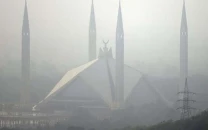Oxygen factories: The million-rupee industry thriving along Karachi streets
An estimated 5,000 nurseries are established on different streets of the city.

These nurseries established along main thoroughfares in Karachi provide a lucrative source of income for their owners besides giving the environment a more pleasant feel. PHOTOS: ATHAR KHAN/EXPRESS
In a city such as Karachi, where land is the most precious commodity, there is little space left to have huge stretches of trees, especially in district Central. An alternative, devised by some clever mind a long time ago, was to allow nurseries to develop along the sides of major roads. These would help control air pollution, as well as stop land grabbers from encroaching precious land.
The benefits of these nurseries, as Farid Ahmed found, were plenty. When Ahmed came to Karachi looking for work, he met Sharifuddin who was helpless in the face of the transport mafia that had encroached the front wall of his house in alHilal Society and built a bus stop. They both decided to help each other out.
Sharifuddin allowed Ahmed to build a nursery along the front wall. Now Ahmed had a job and Sharif had a beautiful nursery in front of his house. “Those transporters had ruined our private lives,” recalled Sharifuddin. “There was so much noise pollution and they parked their vehicles right in front of our house.”

These nurseries established along main thoroughfares in Karachi provide a lucrative source of income for their owners besides giving the environment a more pleasant feel. PHOTOS: ATHAR KHAN/EXPRESS
AlHilal society is located adjacent to the Old Sabzi Mandi, where the city administration developed a park after relocating the market to Super Highway. The authorities had been, however, helpless against the transport mafia, who refused to shift their terminal outside the city at that time.
“Now, the area has been cleared of all kinds of encroachments and the nursery and park present a beautiful aesthetic view of the area,” said Farid Ahmed. “Added to this is the fact that the nursery is a source of bread and butter for me and my family.”
Lucrative business
Nurseries have been established at several green belts and islands across the city. These nurseries not only benefit the environment but are also a lucrative source of income for their owners. “Can you imagine this small plant will fetch as much as Rs1.2 million?” remarked a nursery owner, Abid Paracha, pointing to a bonsai plant. He added that the prices of plants such as cacti, palms and bonsai generally ranged between Rs100 to Rs0.2 million. “Imagine plants worth millions of rupees growing along the city’s footpaths.”
The Karachi Metropolitan Corporation Parks director, Tahir Durrani, explained to The Express Tribune how the system operated under the rules of the parks and horticulture department. “Contractors are issued a temporary licence for the nursery for which they are charged Rs3,000 per month for every 1,000 square yards.”

According to Durrani, around 82 major nurseries are operating along various roads that fall under the KMC’s jurisdiction. These include Shaheed-e-Millat Road, Sharae Faisal, University Road, Safoora Goth, Rashid Minhas Road, Karsaz Road and Korangi Road.
The other nurseries which fall under the district municipal corporations’ jurisdiction operate according to the rules of the respective DMCs. An estimated 5,000 nurseries have been established along different streets and thoroughfares of the city, Durrani claimed.
“We are making the city beautiful by allowing private contractors to establish nurseries on the city’s roads while generating revenue at the same time.”
Published in The Express Tribune, June 6th, 2014.



















COMMENTS
Comments are moderated and generally will be posted if they are on-topic and not abusive.
For more information, please see our Comments FAQ